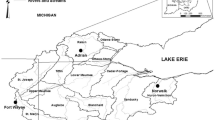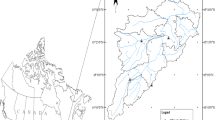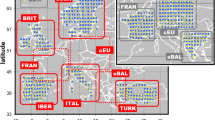Abstract
While Stochastic Weather Generators (SWGs) are used intensively in climate and hydrological applications to simulate hydroclimatic time series and estimate risks and performance measures linked to climate variability, there have been few investigations into how many realizations are required for a robust estimation of these measures. Given the computational cost and time necessary to force climate-sensitive systems with multiple realizations, the estimation of the optimal number of synthetic time series to generate with a particular SWG for a predefined accuracy when estimating a particular risk or performance measure is particularly important. In this paper, the required number of realizations of five SWGs coupled with a SWAT model (the Soil and Water Assessment Tool) needed in order to achieve a predefined Relative Root Mean Square Error is investigated. The statistical indices used are the mean, standard deviation, skewness, and kurtosis of four hydroclimatic variables: precipitation, maximum and minimum temperature, and annual streamflow obtained for each observed and model-generated time series. While the results vary somewhat across SWGs, variables and indicators, they overall show that the marginal improvement decreases dramatically after 25 realizations. The results also indicate that the benefit of generating more than 100 realizations of climate and streamflow data is very minimal. The methodology presented herein can be applied in further investigations of other set of risk indicators, SWGs, hydrological models, and watersheds to minimize the required workload.

















Similar content being viewed by others
References
Ailliot P, Allard D, Monbet V, Naveau P (2015) Stochastic weather generators: an overview of weather type models. J de la Soc Française de Stat 156(1):101–113
Alhassoun S, Sendil U, Al-Othman AA, Negm AM (1997) Stochastic generation of annual and monthly evaporation in Saudi Arabia. Can Water Resour J 22(2):141–154
Al-Mukhtar M, Dunger V, Merkel B (2014) Evaluation of the climate generator model CLIGEN for rainfall data simulation in Bautzen catchment area, Germany. Hydrol Res 45(4–5):615–630
Alodah A (2015). Development of Climate Change Scenarios for the South Nation Watershed. M.A.Sc. Thesis, Civil Engineering, Université d’Ottawa/University of Ottawa. http://dx.doi.org/10.20381/ruor-2801
Alodah A (2019). Stochastic assessment of climate-induced risk for water resources systems in a bottom-up framework. Doctoral dissertation. Civil Engineering, Université d’Ottawa/University of Ottawa. http://dx.doi.org/10.20381/ruor-24004
Alodah A, Seidou O (2019a) The adequacy of stochastically generated climate time series for water resources systems risk and performance assessment. Stoch Environ Res Risk Assess 33(1):253–269. https://doi.org/10.1007/s00477-018-1613-2
Alodah A, Seidou O (2019b) Assessment of climate change impacts on extreme high and low flows: an improved bottom-up approach. Water 11(6):1236. https://doi.org/10.3390/w11061236
Anyah RO, Semazzi FHM (2006) Climate variability over the Greater Horn of Africa based on NCAR AGCM ensemble. Theoret Appl Climatol 86(1–4):39–62
Apipattanavis S, Bert F, Podestá G, Rajagopalan B (2010) Linking weather generators and crop models for assessment of climate forecast outcomes. Agric For Meteorol 150(2):166–174
Baffault C, Nearing MA, Nicks AD (1996) Impact of CLIGEN parameters on WEPP-predicted average annual soil loss. Trans ASAE 39(2):447–457
Bastola S, Murphy C, Fealy R (2012) Generating probabilistic estimates of hydrological response for Irish catchments using a weather generator and probabilistic climate change scenarios. Hydrol Process 26(15):2307–2321
Benoit L, Vrac M, Mariethoz G (2019) Accounting for rain type non-stationarity in sub-daily stochastic weather generators. Hydrol. Earth Syst. Sci. Discuss. https://doi.org/10.5194/hess-2019-562
Box G, Jenkins G (1976) Time series analysis, forecasting and control, 2nd edn. Holden-Day, San Francisco
Breinl K, Di Baldassarre G, Girons Lopez M, Hagenlocher M, Vico G, Rutgersson A (2017) Can weather generation capture precipitation patterns across different climates, spatial scales and under data scarcity? Sci Rep 7(1):5449
Brown C, Werick W, Leger W, Fay D (2011) A decision-analytic approach to managing climate risks: application to the Upper Great Lakes 1. JAWRA J Am Water Resour Assoc 47(3):524–534
Buishand TA (1977) Stochastic modelling of daily rainfall sequences (Doctoral dissertation, Veenman)
Candela L, Tamoh K, Olivares G, Gomez M (2012) Modelling impacts of climate change on water resources in ungauged and data-scarce watersheds. Application to the Siurana catchment (NE Spain). Sci Total Environ 440:253–260
Caron A, Leconte R, Brissette F (2008) An improved stochastic weather generator for hydrological impact studies. Can Water Resour J 33:233–256
Chen J, Brissette FP (2014) Comparison of five stochastic weather generators in simulating daily precipitation and temperature for the loess plateau of China. Int J Climatol 34(10):3089–3105
Chen J, Brissette FP, Leconte R (2010) A daily stochastic weather generator for preserving low-frequency of climate variability. J Hydrol 388(3–4):480–490
Chen J, Brissette FP, Leconte R, Caron A (2012) A versatile weather generator for daily precipitation and temperature. Trans ASABE 55(3):895–906
Chen JF, Brissette X, Zhang J (2014) A multi-site stochastic weather generator for daily precipitation and temperature. Trans ASABE 2014:1375–1391. https://doi.org/10.13031/trans.57.10685
Cohen J (1988) Statistical power analysis for the behavioral sciences, 2nd edn. Lawrence Earlbaum Associates, Hillsdale
Criss RE, Winston WE (2008) Do Nash values have value? Discussion and alternate proposals. Hydrol Process 22(14):2723–2725. https://doi.org/10.1002/hyp.7072
Cunha A Jr, Nasser R, Sampaio R, Lopes H, Breitman K (2014) Uncertainty quantification through the Monte Carlo method in a cloud computing setting. Comput Phys Commun 185(5):1355–1363
Deser C, Phillips A, Bourdette V, Teng H (2012) Uncertainty in climate change projections: the role of internal variability. Clim Dyn 38(3):527–546. https://doi.org/10.1007/s00382-010-0977-x
Dubrovský M, Buchtele J, Žalud Z (2004) High-frequency and low-frequency variability in stochastic daily weather generator and its effect on agricultural and hydrologic modelling. Clim Change 63(1–2):145–179
Eames M, Kershaw T, Coley D (2012) A comparison of future weather created from morphed observed weather and created by a weather generator. Build Environ 56:252–264
Elliot W, Arnold C (2001) Validation of the weather generator CLIGEN with precipitation data from Uganda. Trans ASAE 44:53–58
Fatichi S, Ivanov VY, Paschalis A, Peleg N, Molnar P, Rimkus S, Kim J, Burlando P, Caporali E (2016) Uncertainty partition challenges the predictability of vital details of climate change. Earth’s Future 4(5):240–251. https://doi.org/10.1002/2015EF000336
Fodor N, Dobi I, Mika J, Szeidl L (2013) Applications of the MVWG multivariable stochastic weather generator. Sci World J. https://doi.org/10.1155/2013/571367
Furrer EM, Katz RW (2008) Improving the simulation of extreme precipitation events by stochastic weather generators. Water Resour Res. https://doi.org/10.1029/2008WR007316
Gabriel KR, Neumann J (1962) A Markov chain model for daily rainfall occurrence at Tel Aviv. Q J R Meteorol Soc 88:90–95
Gitau MW, Chiang LC, Sayeed M, Chaubey I (2012) Watershed modeling using large-scale distributed computing in Condor and the Soil and Water Assessment Tool model. Simulation 88(3):365–380
Gitau MW, Mehan S, Guo T (2018) Weather generator effectiveness in capturing climate extremes. Environ Process 5(1):153–165
Glass GV (1976) Primary, secondary, and meta-analysis of research. Educ Res 5(10):3–8
Goyal MK, Burn DH, Ojha CSP (2013) Precipitation simulation based on k-nearest neighbor approach using gamma kernel. J Hydrol Eng 18:481–487
Guenni L (1994) Spatial interpolation of the parameters of stochastic weather models. Climate Change, Uncertainty and Decision Making, Institute for Risk Research, University of Waterloo, Ontario and IGBP-BAHC, Berlin, 61–79
Guo T, Mehan S, Gitau MW, Wang Q, Kuczek T, Flanagan DC (2018) Impact of number of realizations on the suitability of simulated weather data for hydrologic and environmental applications. Stoch Environ Res Risk Assess 32(8):2405–2421
Han B, Benner SG, Flores AN (2019) Including Variability across Climate Change Projections in Assessing Impacts on Water Resources in an Intensively Managed Landscape. Water 11(2):286
Hansen JW, Ines AV (2005) Stochastic disaggregation of monthly rainfall data for crop simulation studies. Agric For Meteorol 131:233–246
Hayhoe HN (1998) Relationship between weather variables in observed and WXGEN generated data series. Agric For Meteorol 90:203–214
Hayhoe HN (2000) Improvements of stochastic weather data generators for diverse climates. Clim Res 14(2):75–87. https://doi.org/10.3354/cr014075
Ivanov VY, Bras RL, Curtis DC (2007) A weather generator for hydrological, ecological, and agricultural applications. Water Resour Res 43(W10):406. https://doi.org/10.1029/2006WR005,364
Jeong DI, St-Hilaire A, Ouarda TB, Gachon P (2012) Multisite statistical downscaling model for daily precipitation combined by multivariate multiple linear regression and stochastic weather generator. Clim Change 114(3–4):567–591
Kilsby CG, Jones PD, Burton A, Ford AC, Fowler HJ, Harpham C, Wilby RL (2007) A daily weather generator for use in climate change studies. Environ Model Softw 22(12):1705–1719
Kim BS, Kim HS, Seoh BH, Kim NW (2007) Impact of climate change on water resources in Yongdam Dam Basin, Korea. Stoch Environ Res Risk Assess 21:355
Kim J, Tanveer ME, Bae DH (2018) Quantifying climate internal variability using an hourly ensemble generator over South Korea. Stoch Environ Res Risk Assess 32(11):3037–3051
Kou X, Ge J, Wang Y, Zhang C (2007) Validation of the weather generator CLIGEN with daily precipitation data from the Loess Plateau, China. J Hydrol 347(3–4):347–357
Kwon HH, Sivakumar B, Moon YI, Kim BS (2011) Assessment of change in design flood frequency under climate change using a multivariate downscaling model and a precipitation-runoff model. Stoch Environ Res Risk Assess 25(4):567–581
Mehan S, Guo T, Gitau M, Flanagan DC (2017) Comparative study of different stochastic weather generators for long-term climate data simulation. Climate 5(2):26
Mehrotra R, Srikanthan R, Sharma A (2006) A comparison of three stochastic multi-site precipitation occurrence generators. J Hydrol 331(1–2):280–292
Min YM, Kryjov VN, An KH, Hameed SN, Sohn SJ, Lee WJ, Oh JH (2011) Evaluation of the weather generator CLIGEN with daily precipitation characteristics in Korea. Asia-Pacific J Atmos Sci 47(3):255–263
Minville M, Brissette F, Leconte R (2008) Uncertainty of the impact of climate change on the hydrology of a nordic watershed. J Hydrol 358:70–83
Mithen S, Black E (2011) Water, life and civilisation: climate, environment and society in the Jordan Valley. Cambridge University Press, Cambridge
Mukundan R, Acharya N, Gelda RK, Frei A, Owens EM (2019) Modeling streamflow sensitivity to climate change in New York City water supply streams using a stochastic weather generator. J Hydrol: Reg Stud 21:147–158
Neitsch SL, Arnold JG, Kiniry JR, Williams JR (2011) Soil and water assessment tool theoretical documentation version 2009. Texas Water Resources Institute
Onof C, Chandler RE, Kakou A, Northrop P, Wheater HS, Isham V (2000) Rainfall modelling using Poisson-cluster processes: a review of developments. Stoch Environ Res Risk Assess 14(6):384–411
Oriani F, Straubhaar J, Renard P, Mariethoz G (2014) Simulation of rainfall time-series from different climatic regions using the direct sampling technique. Hydrol Earth Syst Sci Discuss 11:3213–3247
Ott RL, Longnecker MT (2015) An introduction to statistical methods and data analysis. Thomson Learning, Inc. Duxbury, Pacific Grove, CA, Nelson Education
Panagoulia D (2006) Artificial neural networks and high and low flows in various climate regimes. Hydrol Sci J 51(4):563–587
Panagoulia D, Tsekouras GJ, Kousiouris G (2017) A multi-stage methodology for selecting input variables in ANN forecasting of river flows. Glob Nest J 19:49–57
Peleg N, Fatichi S, Paschalis A, Molnar P, Burlando P (2017) An advanced stochastic weather generator for simulating 2-D high-resolution climate variables. J Adv Model Earth Syst 9(3):1595–1627
Qian B, Gameda S, Hayhoe H, De Jong R, Bootsma A (2004) Comparison of LARS-WG and AAFC-WG stochastic weather generators for diverse Canadian climates. Clim Res 26(3):175–191
Racsko P, Szeidl L, Semenov M (1991) A serial approach to local stochastic weather models. Ecol Model 57(1–2):27–41
Räisänen J, Ruokolainen L (2006) Probabilistic forecasts of near-term climate change based on a resampling ensemble technique. Tellus A: Dyn Meteorol Oceanogr 58(4):461–472
Richardson CW (1981) Stochastic simulation of daily precipitation, temperature, and solar radiation. Water Resour Res 17(1):182–190
Rodriguez-Iturbe I, Cox DR, Isham V (1987) Some models for rainfall based on stochastic point processes. Proc R Soc Lond A. Math Phys Sci 410(1839):269–288
Rosnow RL, Rosenthal R (1996) Computing contrasts, effect sizes, and counternulls on other people’s published data: general procedures for research consumers. Pyschol Methods 1:331–340
Santer BD, Thorne PW, Haimberger L, Taylor KE, Wigley TML, Lanzante JR, Karl TR (2008) Consistency of modelled and observed temperature trends in the tropical troposphere. Int J Climatol: J R Meteorol Soc 28(13):1703–1722
Schoof JT, Pryor SC (2008) On the proper order of markov chain model for daily precipitation occurrence in the contiguous United States. J Appl Meteorol Climatol 47(9):2477–2486. https://doi.org/10.1175/2008JAMC1840.1
Semenov MA (2008) Simulation of extreme weather events by a stochastic weather generator. Clim Res 35(3):203–212
Semenov MA, Barrow EM (1997) Use of a stochastic weather generator in the development of climate change scenarios. Clim Change 35:397–414
Semenov MA, Brooks RJ, Barrow EM, Richardson CW (1998) Comparison of the WGEN and LARS-WG stochastic weather generators for diverse climates. Clim Res 10(2):95–107
Sharif M, Burn DH (2007) Improved K-nearest neighbor weather generating model. J Hydrol Eng 12(1):42–51
Smith BJ (2007) BOA: an R package for MCMC output convergence assessment and posterior inference. J Stat Softw 21(11):1–37
Soltani A, Hoogenboom G (2003a) A statistical comparison of the stochastic weather generators WGEN and SIMMETEO. Clim Res 24(3):215–230
Soltani A, Hoogenboom G (2003b) Minimum data requirements for parameter estimation of stochastic weather generators. Clim Res 25(2):109–119. https://doi.org/10.3354/cr025109
Steinschneider S, Brown C (2013) A semiparametric multivariate, multisite weather generator with low-frequency variability for use in climate risk assessments. Water Resour Res 49(11):7205–7220
Stevens T, Madani K (2016) Future climate impacts on maize farming and food security in Malawi. Sci Rep 6:36241
Stowasser Markus (2012) Modelling rain risk: a multi-order markov chain model approach. J Risk Finance 13(1):45–60
Thompson C, Thomson P, Zheng X (2007) Fitting a multisite rainfall model to New Zealand data. J Hydrol 340:25–39
Thompson DWJ, Barnes EA, Deser C, Foust WE, Phillips AS (2015) Quantifying the role of internal climate variability in future climate trends. J Clim 28(16):6443–6456. https://doi.org/10.1175/JCLI-D-14-00830.1
Todorovic P, Woolhiser DA (1975) A stochastic model of n-day precipitation. J Appl Meteorol 14:17–24
Vacha-Haase T, Thompson B (2004) How to estimate and interpret various effect sizes. J Couns Psychol 51:473–481. https://doi.org/10.1037/0022-0167.51.4.473
Vesely FM, Paleari L, Movedi E, Bellocchi G, Confalonieri R (2019) Quantifying uncertainty due to stochastic weather generators in climate change impact studies. Sci Rep 9:1–8
Vu TM, Mishra AK, Konapala G, Liu D (2018) Evaluation of multiple stochastic rainfall generators in diverse climatic regions. Stoch Environ Res Risk Assess 32(5):1337–1353
Wheater HS, Chandler RE, Onof CJ, Isham VS, Bellone E, Yang C, Segond ML (2005) Spatial-temporal rainfall modelling for flood risk estimation. Stoch Environ Res Risk Assess 19(6):403–416
Wilby RL, Charles SP, Zorita E, Timbal B, Whetton P, Mearns LO (2004) Guidelines for use of climate scenarios developed from statistical downscaling methods. Supporting material of the Intergovernmental Panel on Climate Change, available from the DDC of IPCC TGCIA, 27
Zhang X, Garbrecht JD (2003) Evaluation of CLIGEN precipitation parameters and their implication on WEPP runoff and erosion prediction. Trans ASAE 46:311
Zwiers F (1996) Interannual variability and predictability in an ensemble of AMIP climate simulations conducted with CCC GCM2. Clim Dyn 12:825–847
Acknowledgements
The authors would like to thank the Associate Editor and the anonymous referees for their comments and thoughtful review of an early version of the article, which greatly improved the article.
Author information
Authors and Affiliations
Corresponding author
Additional information
Publisher's Note
Springer Nature remains neutral with regard to jurisdictional claims in published maps and institutional affiliations.
Rights and permissions
About this article
Cite this article
Alodah, A., Seidou, O. Influence of output size of stochastic weather generators on common climate and hydrological statistical indices. Stoch Environ Res Risk Assess 34, 993–1021 (2020). https://doi.org/10.1007/s00477-020-01825-w
Published:
Issue Date:
DOI: https://doi.org/10.1007/s00477-020-01825-w




